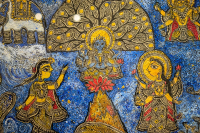Culture & Lifestyle
The thin line between artistic homage and cultural appropriation
When it comes to exercising creative freedom on digital platforms, what are the limitations—particularly when it comes to cultural references?
Shashwat Pant
In May, Utsav Dev Manandhar, a computer engineering student, currently studying at Southern Illinois University in the US, started a project. He decided to create a game that would pay homage to Kathmandu’s culture and heritage. And as Yenya:, more commonly known as Indra Jatra, is one of the grandest festivals of the Newa people of Kathmandu and was just around the corner, he decided to use two of the festival’s most iconic motifs—Majipa Lakhey and Pulukisi—to make an endless runner game, similar to the popular Temple Run.
Manandhar set himself a four-month deadline and during that time worked around 600 hours researching and learning how to use different software in order to complete the game on time. He regularly posted updates on his Instagram page Mandhu Studios, to keep people more engaged about the game and was getting a lot of positive comments.
But on the eve of the launch, Manandhar decided against launching his game. A few weeks prior, he had started getting many negative comments on social media, passively threatening him for using cultural elements in a game.
“I got messages stating that I was wrong to use Lakhey and Pulukisi in a game,” says the 21-year-old. “But my intentions were not to disrespect our culture. It was to promote it in a different manner.”
Not wanting to hurt the sentiments of the people who had been involved in the preservation of the Majipa Lakhey for over a century, he decided to take a step back with the game.
“It was obviously disappointing. I’d spent four months doing this and when it was time for release I had to call it off. I realised there was no point releasing it if people didn’t like it,” says Manadhar. “I understand their perspective too and respect their point of view on the issue.”
While this issue has been absolved with Manandhar choosing not to launch his game, it does raise a critical question: when it comes to exercising creative freedom, what are the limitations—particularly when it comes to cultural references?
The guthis associated with the Majipa Lakhey and the Pulukisi, who Manandhar contacted after receiving negative comments to get an understanding of their perspective, believe the use of cultural motifs should not have a place in games.
“They acknowledged my efforts, but they said that doing such things will only cause problems in the future. They said that there were chances that it might be misused,” says Manandhar.
They further told him that culture should not be promoted with the help of the game and a god shouldn’t be part of a game. The head of the Majipa Lakhey Guthi, Rajib Ranjit, appreciating Manandhar’s work said that even though his intentions might have been good, there were chances that people would misuse it.
“We saw what happened to the filter someone created about the Kumari a few months ago. Even that guy’s intention was not bad. But a few people did misuse the filter,” said Ranjit, pointing out to an Instagram filter created by designer and comedian Ayush Shrestha.
Ranjit further said that a game could be developed with any character, then why use one associated with a culture. “Our faith is very strong. And we strongly believe that it should not be played with,” says Ranjit.
But not all are on the same page. Sanyukta Shrestha, a game developer based in the United Kingdom, says that he was saddened by the news of a young innovator like Manandhar dropping a project for reasons that had little to do with his skills.
“In my view, this is clearly an act of bullying. Of course, the stakeholders of Lakhey dance and Indra Jarta can have a say on anything related to the culture but they are neither the authority nor the experts to decide what is good for creative, digital platforms including the interpretations of the Lakhey culture,” says Sanyukta.
But Ranjit does not agree with Sanyukta. “We’ve not said don’t make a game, just don’t put our god on it. If you want to make something by putting a Lakhey on it, come to us, talk about it and then make it. We don’t want factually incorrect things to be put out there. You can make an animated video or a comic. We’ve never stopped people from doing that,” says Ranjit.
Sanyukta says that he says he too has been a victim of such comments in the past, not directly from the Lakhey guthi but from people who claim to be. An example he says can be seen on the trailer of his animated movie Majipa:Lakhey.
“They’ve been targeting me too with some baseless accusations. But I don't care about such comments,” says Sanyukta.
Developing a game related to Nepali culture isn’t something new. In fact, there are games, like Sanyukta's Save Your Yomari, which he has been developing for the past two years, that can be used as a medium to teach young people about culture. For instance, Sanyukta’s game teaches children the history of Yomari (a sweet dish made with rice flour and molasses), how it's made and its significance in Newa homes. Every year, hundreds of children play the game and after playing the game, actually make yomaris along with their parents, says Sanyukta.
Coming to Manandhar's game, Sanyukta says that the Lakhey culture is as much theirs as it is his or even any other Nepali outside the Newa community. He says that it is a world heritage and not a single individual or team's copyright.
But Sanyukta says that despite the popularity his game has received, he still has gotten repeated comments on social media telling him that they have to seek permission from the guthi to host any event in the UK.
“People I don't know or who they are associated with send messages and comments on the issue. One even wrote that they’ll file a copyright lawsuit because we observed Indra Jatra in London,” says Sakyukta.
“As an artist, writer and free thinker, I always encourage all other youth not to be influenced by such pressures and carry on with all honesty and conviction in what they believe in.”
Historian Sudarshan Raj Tiwari says that it's better to keep away from things that affect religious sentiments, especially during a time when people are playing the identity politics card. But he says that if the motifs that are being used don't paint a bad picture, it should be allowed.
“If it does not affect the originality of the festival or misrepresent it, it shouldn’t matter,” says Tiwari. “Because things like these can actually create mass awareness, as it puts content out there for thousands to see. It can be a good education tool—if done correctly.”
He further adds that some people can see harm in some of the simplest things. But he argues that people should point out what mistakes were made or how it would be bad for the community or culture in general.
“Yes, they are stakeholders and have the right to take ownership, but they need to be a bit open about it too. Times have changed now,” says Tiwari.
But Manandhar has made his mind up. He says he doesn’t want to release the game if people don’t like it. “I’ll make some changes and try to launch it differently,” says Manandhar. “What this whole issue has taught me is to stay away from cultural references when doing things like these.”




 5.39°C Kathmandu
5.39°C Kathmandu













%20(1).jpg&w=300&height=200)

